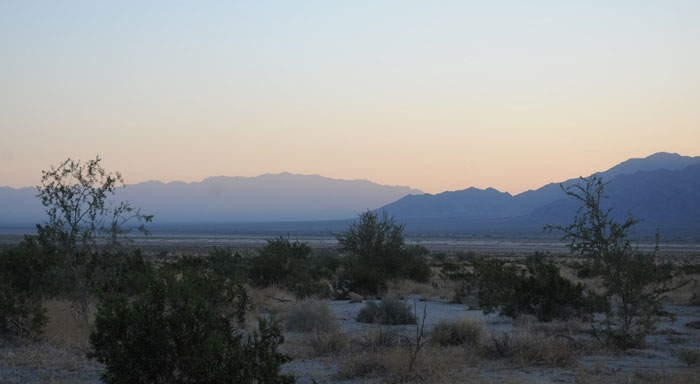June Site Visit
June 4-5, 2010 - Chuckwalla Valley, Riverside County -
We camped out at the site of the large solar thermal power plant proposal by Solar Millennium on a valley slope north of the Interstate 10 in the Colorado Desert. The area is remarkably undisturbed, with only two small dirt roads crossing it along with a low wooden-pole road. The Sand verbenas were still blooming pink in the sandy gravelly flats among creosote bushes. Washes crossed the fan, holding a different plant community, sparse Palo verde-Ironwood woodland.
Mourning doves (Zenaida macroura) fly by the desert scrubland as the sun set, Northern mockingbirds (Mimus polyglottos) sang from small trees, a Loggerhead shrike (Lanius ludovicianus) called harshly while hunting lizards, Horned lark (Eremophila alpestris) flocks rose as we walked down a wash, and an Ash-throated flycatcher (Myiarchus cinerascens) perched in tall creosote.
Black-tailed jackrabbits (Lepus californicus) ran across the desert as Round-tailed ground squirrels (Xerospermophilus tereticaudus) peeped from their burrows. White-tailed antelope ground squirrels (Ammospremophilus leucurus) were more daring, showing themselves above-ground.
Zebra-tailed lizards (Callisaurus draconoides) dashed across washes, while Western whiptails (Cnemidophorus tigris) hunted insects in leaf litter. We found a Desert horned lizard (Phrynosoma platyrhinos) near ant hills.
The place was peaceful and wild even as the temperature climbed to 102 degrees Fahrenheit during the day. The Milky Way glittered brilliantly at midnight across the wide open sky.
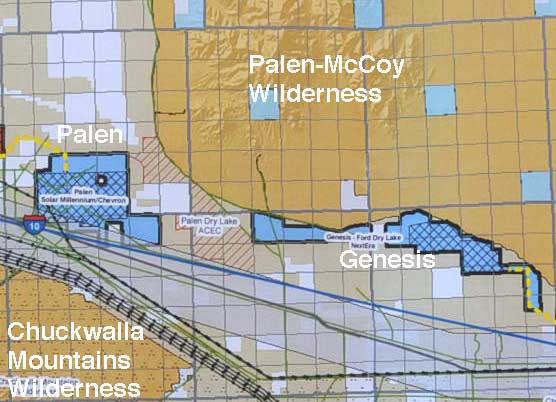
^Solar Millennium Palen Solar Power Project in blue. NextEra's Genesis Solar power Project is to the east.

^Early morning sky.
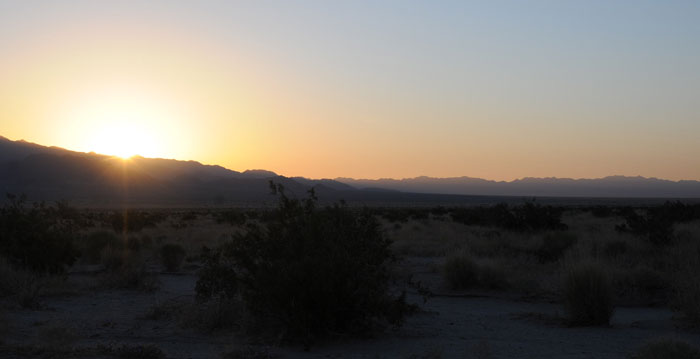
^Sunrise over the Palen Mountains.

^Morning light bathes the creosote desert on the project site.
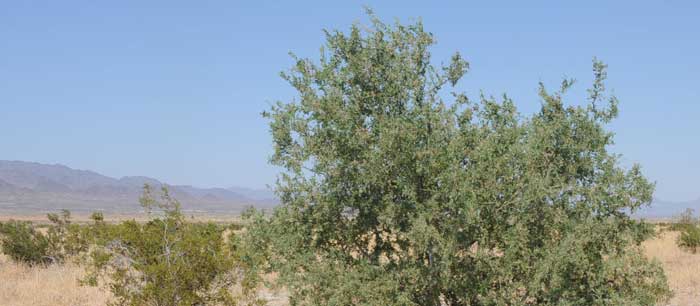
^Desert ironwood (Olneya tesota).
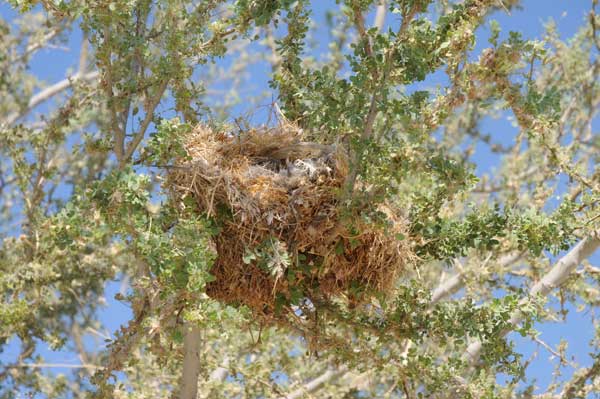
^A recently used nest, perhaps of a Cactus wren, in an Ironwood.
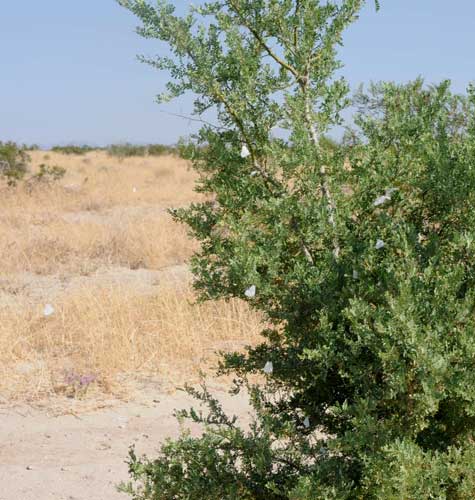
^Clouds of white butterflies rose from an Ironwood as I walked by.
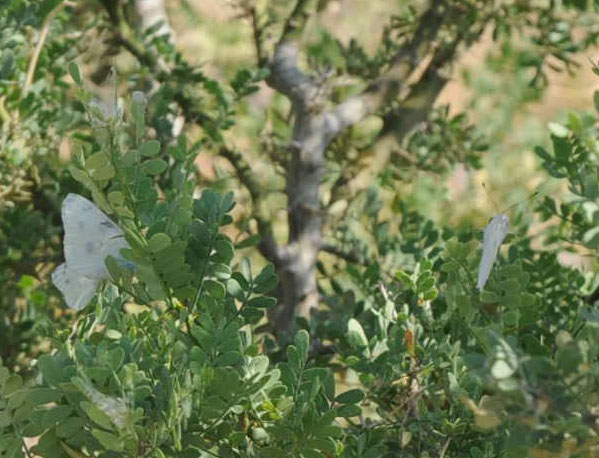
^Then they settled back down on the Ironwood leaves.

^White butterflies of the family Pieridae at Ironwood. These may be Checkered whites (Pontia protodice). The larvae feed on mustards.
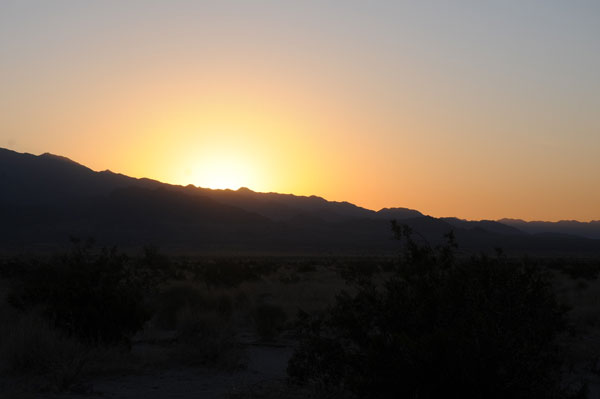
^Dawn over the Palen Mountains, seen from the middle of the project site.
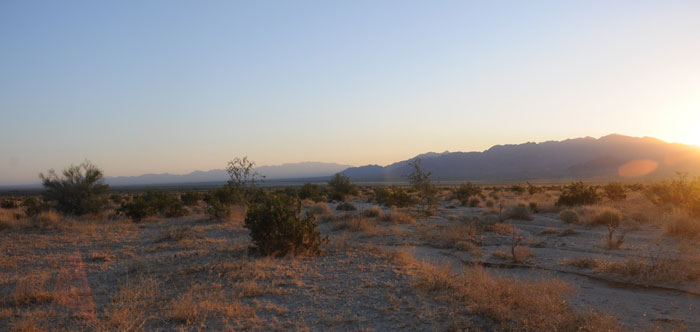
^Dawn light over the project, looking northwards.

^Palo verde (Parkinsonia florida) at sunrise.
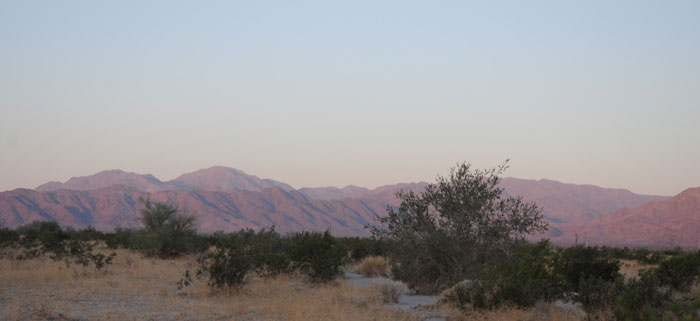
^The Chuckwalla Mountains Wilderness in early morning light, from the project site.
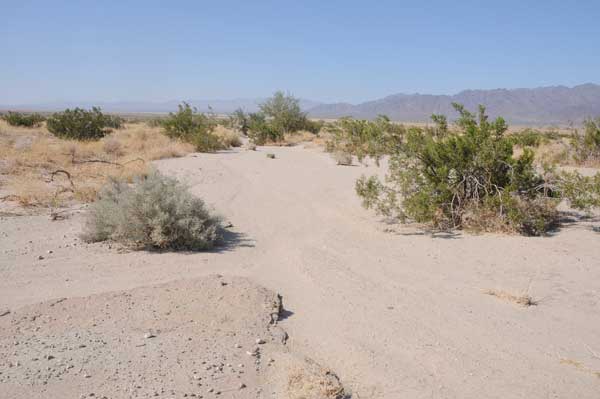
^Wash come through the site where the solar field will be located.
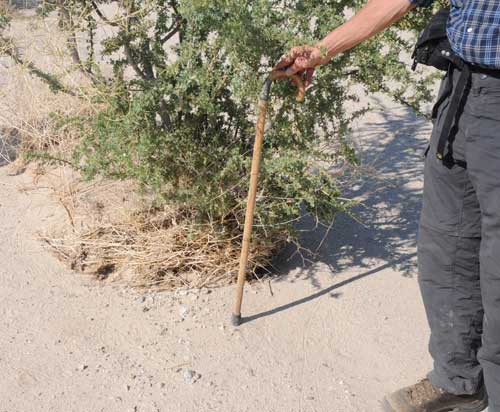
^Debris jams up against a small Ironwood tree in the wash. This is an active flood system.
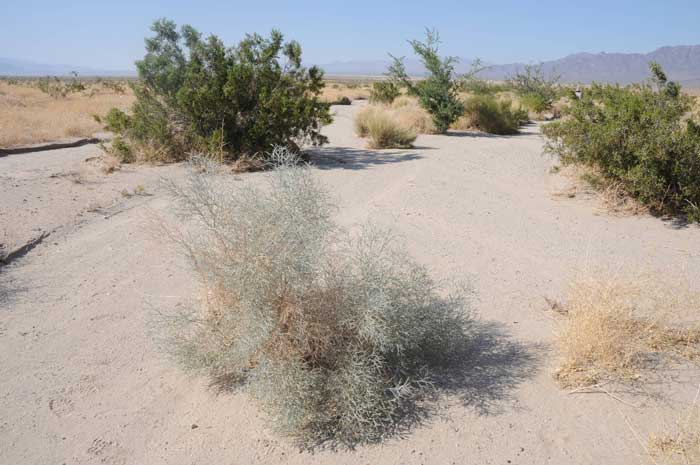
^Young Smoke tree (Psorothamnus spinosus) in the wash.
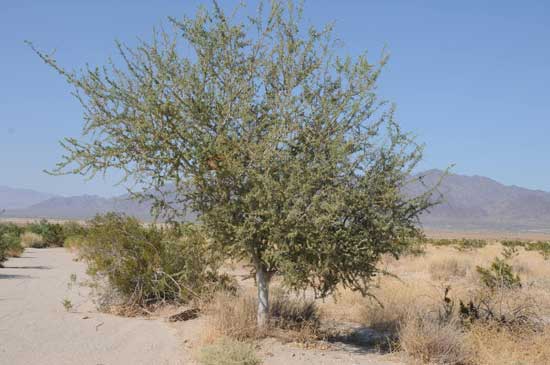
^Ironwood.

^Big galleta grass (Pleuraphis rigida) in the wash.
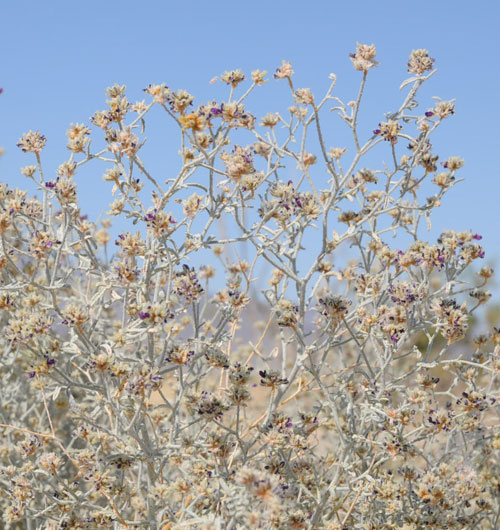
^Dye bush (Psorothamnus emoryi) in the wash.

^Early dawn with creosote (Larrea tridentata) and Galleta grass.
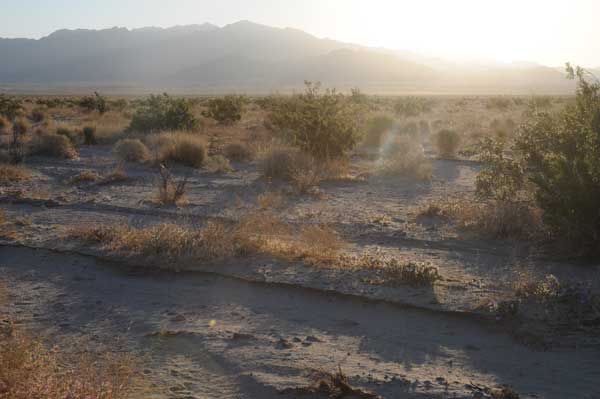
^Morning sunlight.
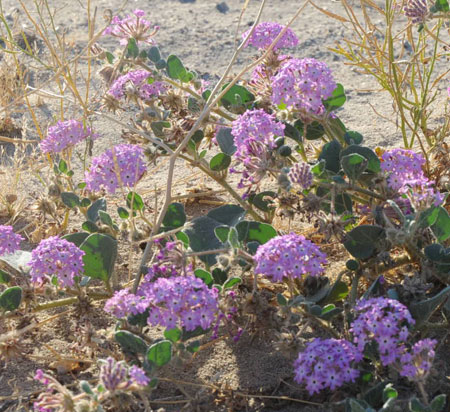
^Desert sand verbena.

^Ironwood at dawn.
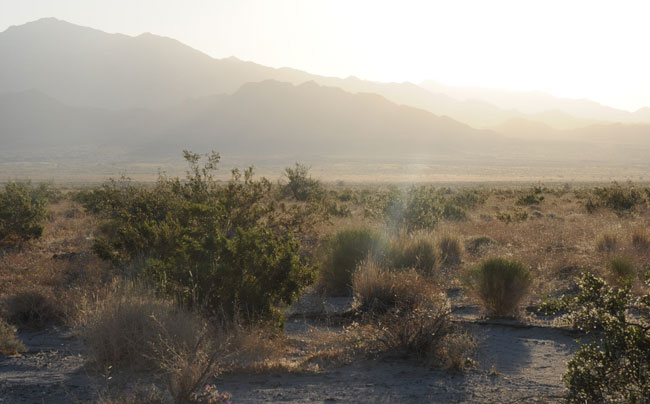
^Morning sunrise on the project site.
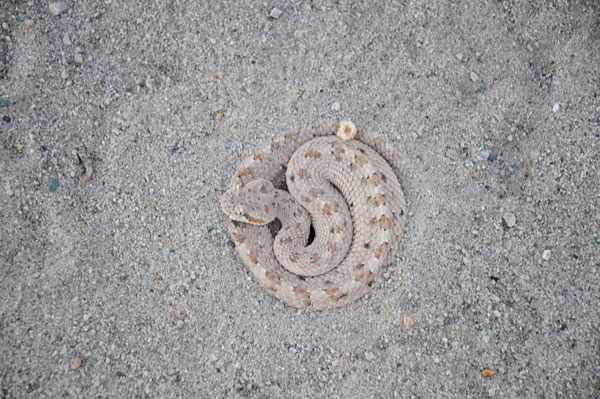
^We came upon this small Sidewinder (Crotalus cerastes) embedded in the sand of the wash at sunrise. This "cratering" behavior, where the snake circles into the sand and digs in, may be to absorb the residual heat of the ground after a night of hunting.

^Look carefully in the lower picture, the flattened, dug-in Sidewinder lies hidden in the sand.
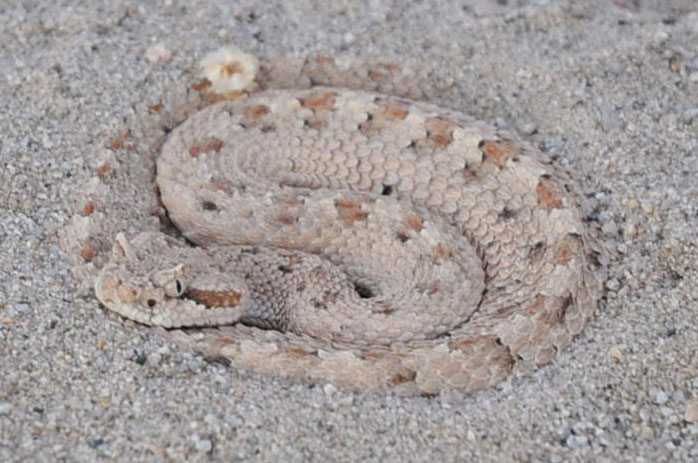
^Sidewinder partly buried, still and not rattling.
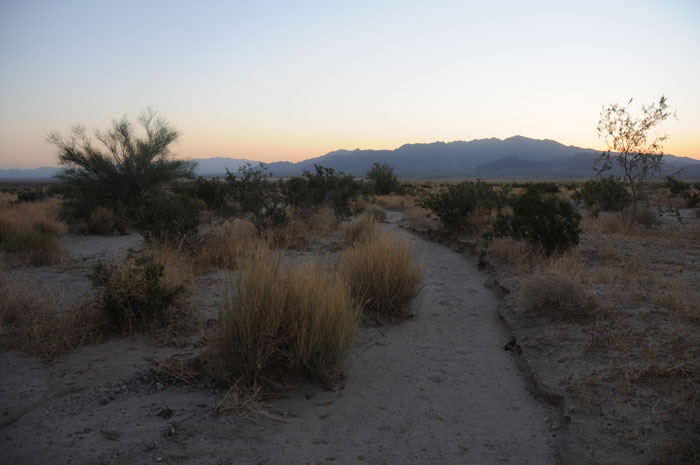
^Pre-dawn in the wash with Galleta grass, Creosote, Ironwood, and Palo verde. Palen Mountains in the background.
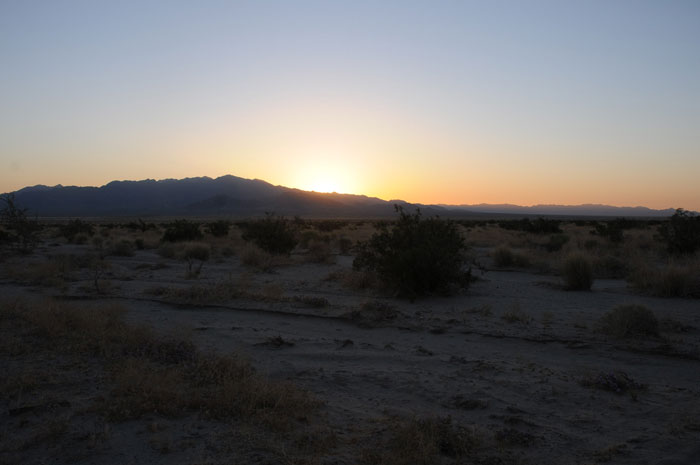
^The sun behind the Palen Mountains.

^Little denizens of the night: a Merriam's kangaroo rat (Dipodomys merriami) hops about in the early morning before sunrise, collecting seeds in its cheek pouches.
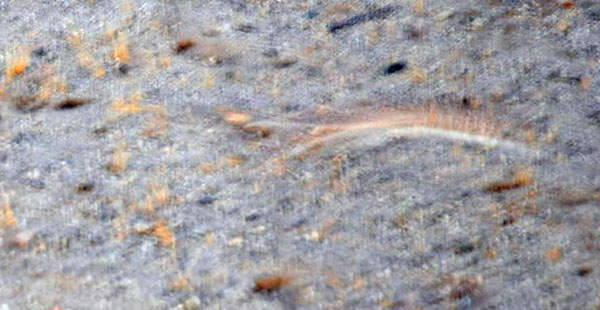
^The kangaroo rat jumps off in a streak.
Chuckwalla Mountains Wilderness
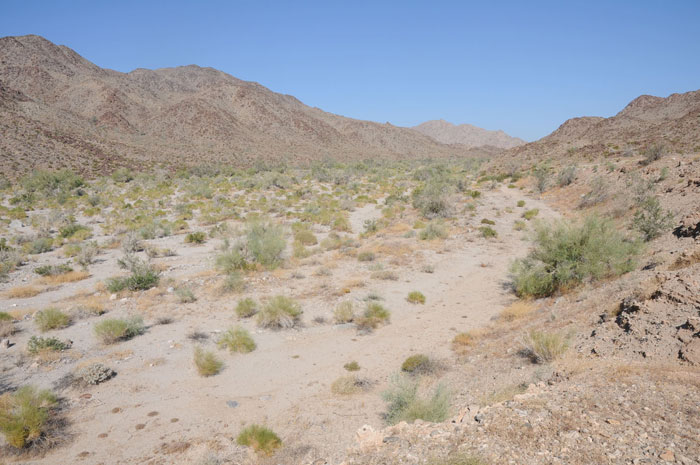
^Large wash pours out of the Chuckwalla Mountains in the wilderness area. Chuckwalla Mountains Wilderness is located south of the Interstate 10 corridor and the town of Desert Center. It was the last place Pronghorn antelope (Antilocapra americana) were found in the California desert. Critical habitat for Desert tortoise (Gopherus agassizii) lies in the southwestern part.
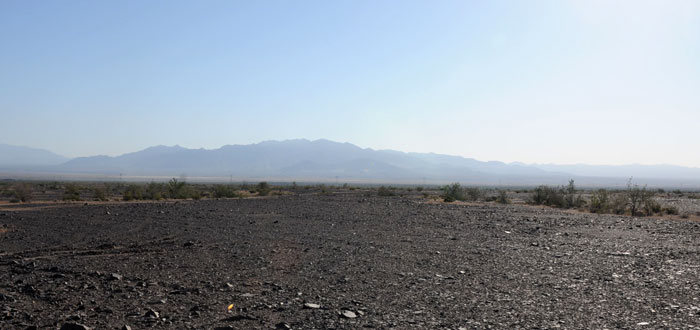
^View from desert pavement in the Chuckwalla Mountains Wilderness looking northwards towards the Palen Solar Power Project to the left and Genesis Solar Power Project to the right in the distance. The Palen Mountains rises on the horizon.
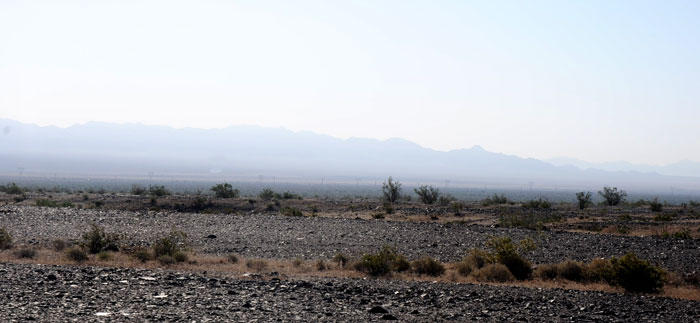
^Genesis site in the distance beyond Ford Dry Lake. Agricultural burning in Blythe to the east created haze this morning.

^Ironwood in a small wash through desert pavement, looking towards the Palen Mountains, from Chuckwalla Mountains Wilderness.
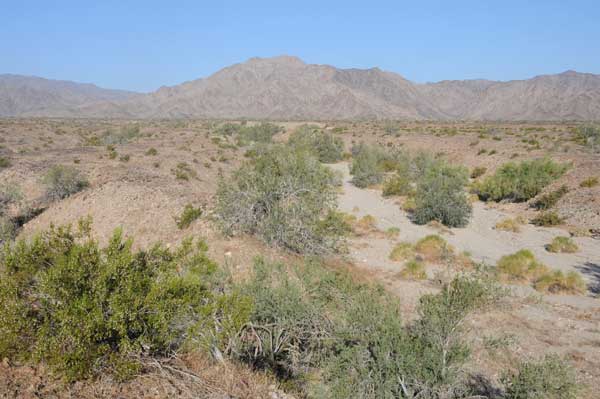
^The wilderness has rocky peaks and a fan dissected by Ironwood washes incised into the desert pavement.

^An Ocotillo (Fouquieria splendens) lines a wash in the wilderness.

^Distant view across the Genesis solar project looking to the McCoy Mountains on the horizon.

^We encountered a 3.5-foot long Mojave rattlesnake (Crotalus scutulatus) basking on the dirt road leading to Corn Spring.

^We stopped to photograph the snake and ease it off the road. It curled into a defensive posture and rattled.

^Then the snake moved under the cover of a Brittlebush (Encelia farinosa) to hold its ground. We left the snake alone and it calmed down and stopped rattling, and we left it to its day.
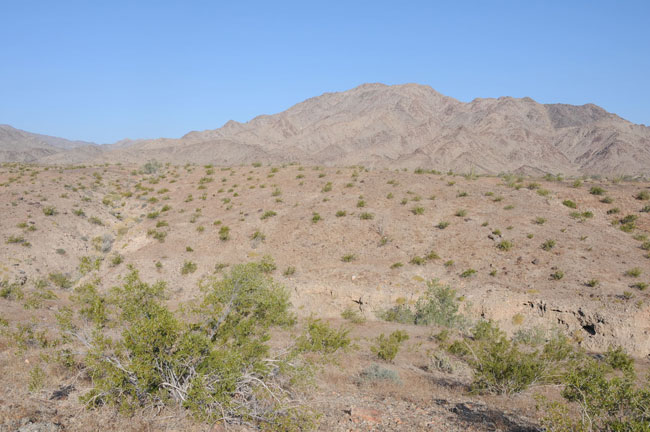
^Chuckwalla Mountains.
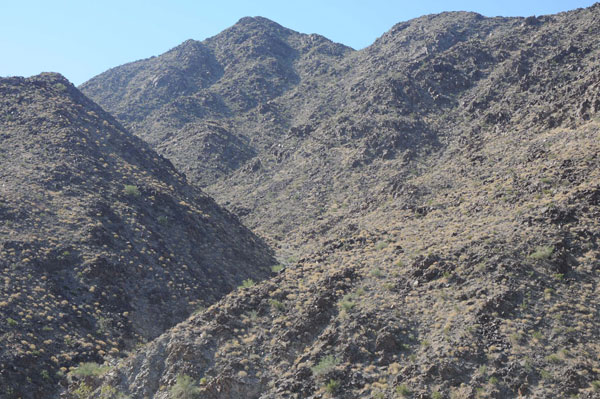
^Desert slopes.
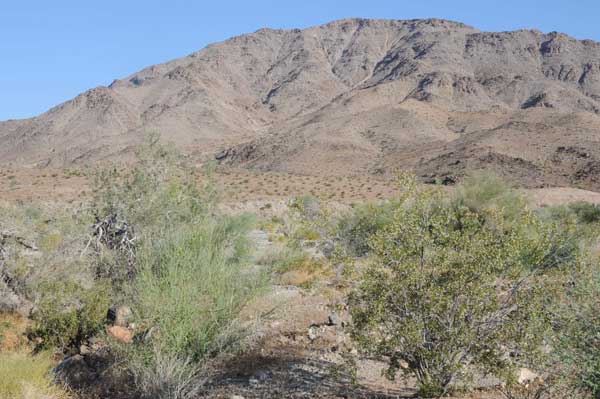
^Palo verde and creosote below the Chuckwalla Mountains.
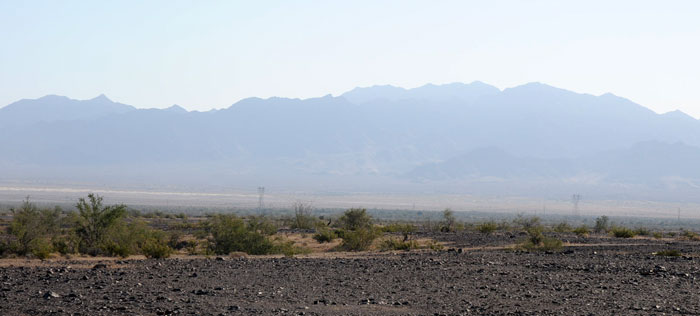
^Palen Dry Lake and the Palen Solar Power Project site below the Palen Mountains, as seen from the upper fan of Chuckwalla Mountains Wilderness.

^Road to Corn Spring. Palen Mountains in the distance.

^Genesis solar project site in the distance.
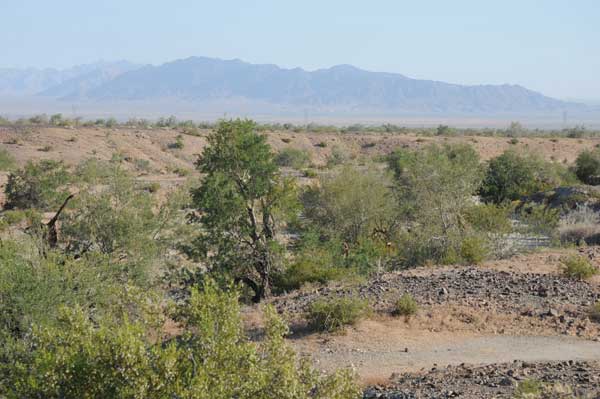
^Ironwood wash.
Corn Springs
The Bureau of Land Management campground cherry-stemmed into the wilderness is a peaceful spring with a cluster of native California fan palms (Washingtonia filifera) that have recently burned but are recovering well. Bighorn sheep (Ovis canadensis) have been reported on the ridges around this canyon. Although temperatures were hot, birds still flew about and sang in the lush oasis: Roadrunner (Geococcyx californianus), Loggerhead shrike, White-winged dove (Zenaida asiatica), Mourning dove, Ladder-backed woodpecker (Picoides scalaris), Gambel's quail (Callipepla gambelii), Verdin (Auriparus flaviceps), Western tanager (Piranga ludoviciana), House finch (Carpodacus mexicanus), Northern mockingbird, and Ash-throated flycatcher.
A Desert collared lizard (Crotaphytus bicinctores) basked on a boulder, as small Side-blotched lizards (Uta stansburiana) and Western whiptails (Cnemidophorus tigris) scurried about after insects on the ground. Desert cottontails (Sylvilagus audubonii) hid in the underbrush.
See the BLM website on Corn Springs Campground.
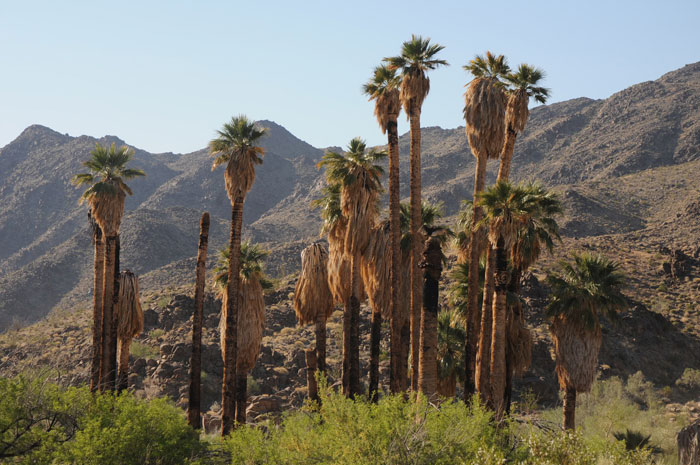
^Native fan palms.
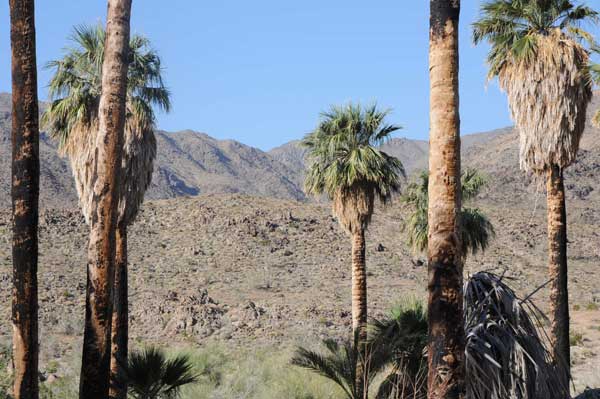

^A lush Honey mesquite thicket (Prosopis glandulosa) houses birds, deer, and rabbits.
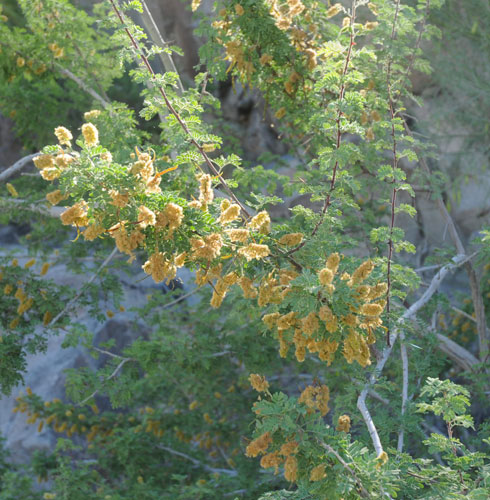
^Catclaw acacia (Acacia greggii).
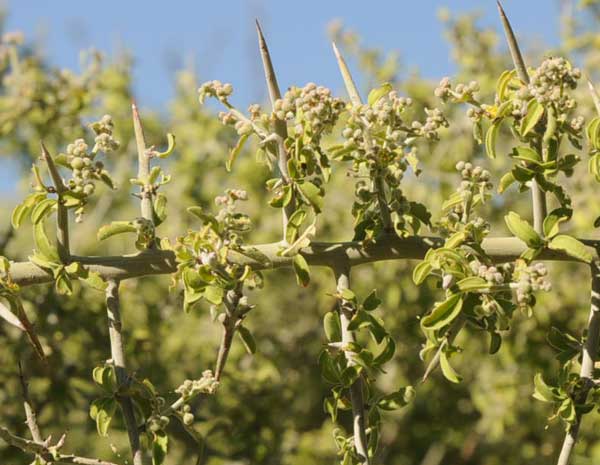
^Graythorn (Zizyphus obtusifolia) with berries growing.
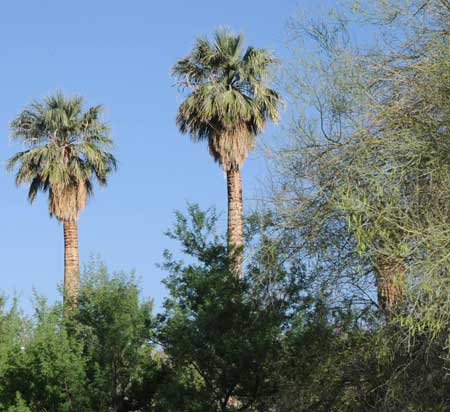
^Fan palms, palo verde, and mesquite.

^Track of the elusive Burro deer (Odocoileus hemionus eremicus), a subspecies of Mule deer endemic o the Colorado Desert of California.

^Wash with Honey mesquite, Palo verde, Desert lavender (Hyptis emoryi), and Cheesebush (Salazaria mexicana).
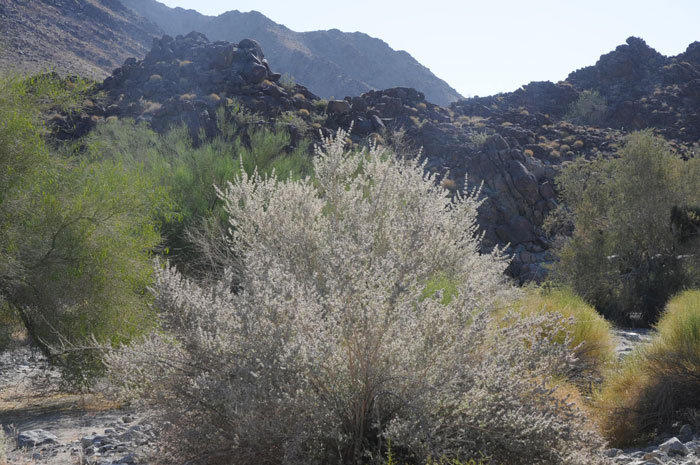
^Desert lavender.
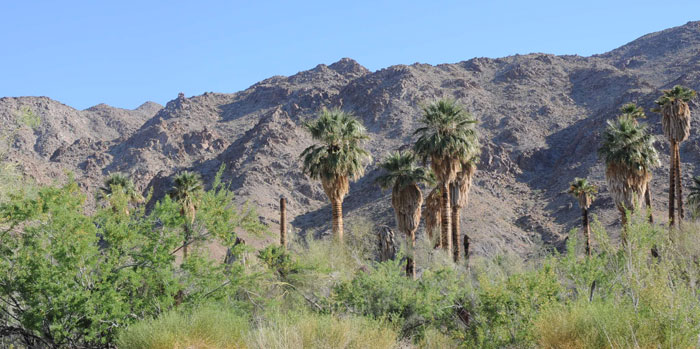
^Fan palm oasis in the Chuckwalla Mountains.
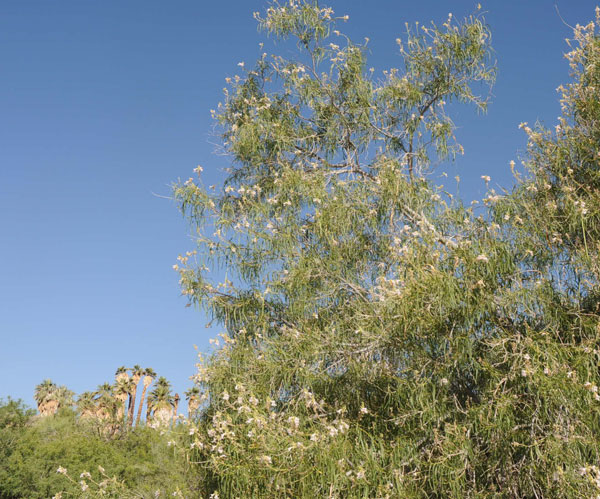
^Desert willow (Chilopsis linearis) in bloom.
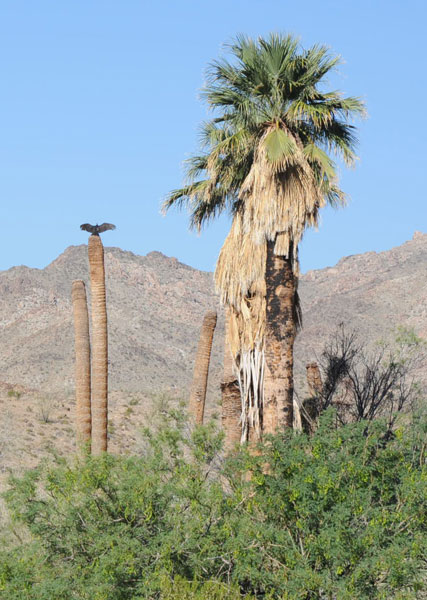
That morning about 16 Turkey vultures (Cathartes aura) perched on top of burned palm trunks, along mesquite limbs, and elsewhere basking in the sun before hot thermals rose from the desert floor.
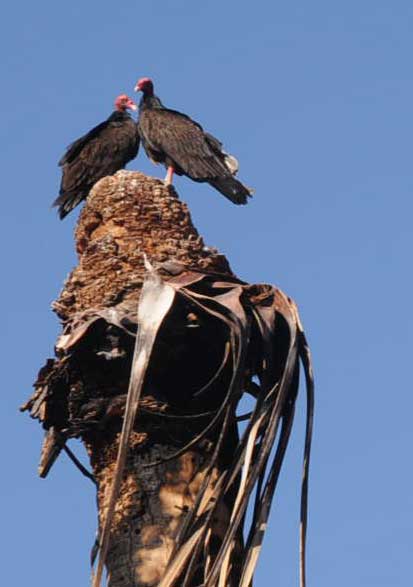
^Turkey vultures on dead palm trunk.
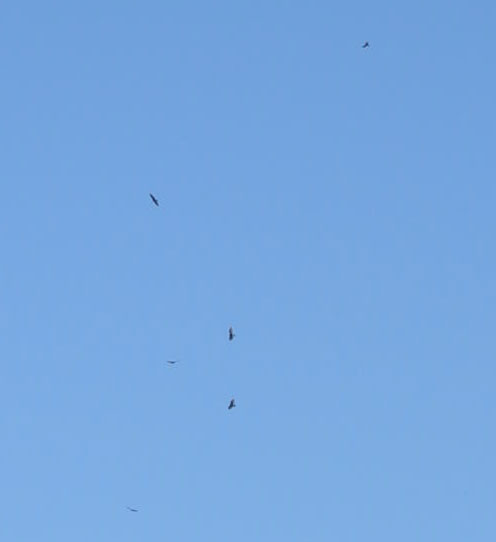
^"Kettle" of Turkey vultures rising on hot upwelling air.

^Campground.
HOME.....April Site Visit.....Updates.....Chuckwalla Valley
